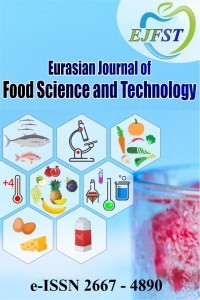Environmentally Friendly Bacterial Cellulose Films for Food Packaging
Environmentally Friendly Bacterial Cellulose Films for Food Packaging
Bacterial cellulose food packaging, cling wrap, microbial load,
___
- Abdul Khalil H.P.S., Y. Davoudpour Y., Chaturbhuj K. Saurabh C.K., Hossain S., Adnan A. S., Dungani R., Paridah M.T., Islam Sarker Z., Nurul Fazita M.R., Syakir M.I., & Haafiz. M.K.M. 2016. A review on nanocellulosic fibres as new material for sustainable packaging: Process and applications, Renewable and Sustainable Energy Reviews, 64, 823–836.
- Aider M. 2010. Chitosan application for active bio-based films production and potential in the food industry, Food Science & Technology, 43, 837-842.
- Arvanitoyannis I.S. & Kotsanopoulos K.V. 2014. Migration phenomenon in food packaging. Food–package interactions, mechanisms, types of migrants, testing and relative legislation, Food and Bioprocess Technology, 7, 21-36.
- Atares L. & Chiralt A. 2016. Essential oils as additives in biodegradable films and coatings for active food packaging, Trends in Food Science & Technology, 48, 51-62.
- Azeredo H.M.C., Barud H., Farinas C.S., Vasconcellos V.M. & Claro A.M. 2019. Bacterial cellulose as a raw material for food and food packaging applications, Frontiers in Sustainable Food Systems, 3(7), 1-14.
- Bandyopadhyay S., Saha N. & Saha P. 2020. Comparative analysis of bacterial cellulose based polymeric films for food packaging, AIP Conference Proceedings, 2205, 1-5. Borchers A., Teuber S.S., Keen C.L. & Gershwin M.E. 2010. Food safety, Clinical Reviews in Allergy & Immunology, 39, 95-141.
- Brooks J.D. & Flint S.H. 2008. Biofilms in the food industry: Problems and potential solutions, International Journal of Food Science & Technology, 43(12), 2163-2176.
- Çoban E.P, Şahin S., Bıyık H.H, Özmen I., Ünsal H. & Bengül E. 2017. Antimicrobial and biocompatible bacterial cellulose as wound dressing, Transylvanian Review, 25(22): 1-11.
- Çoban E.P., Bıyık H.H. & Sağlam U.C. 2020. Use of nanocellulose and microcellulose for aniline blue dye removal, Fresenius Environmental Bulletin, 29(11): 9542-9549.
- Drosinos E.H, Mataragas M., Xiraphi N., Moschonas G., Gaitis F. & Metaxopoulos J. 2005. Characterization of the microbial flora from a traditional Greek fermented sausage, Meat Science, 69, 307-317.
- Durusoy R. & Karababa A.O. 2011. Plastic food packaging and health, TAF Preventive Medicine Bulletin, 10(1), 87-96.
- Ferna´ndez-Lo´pez J., Sendra E., Sayas-Barbera E., Navarro C., & Pe´rez-Alvarez J.A. 2008. Physico-chemical and microbiological profiles of ‘‘salchicho´n” (Spanish dry- fermented sa-usage) enriched with orange fiber, Meat Science, 80, 410-417.
- Hestrin S. &Schramm M. 1954. Synthesis of cellulose by Acetobacter xylinum: preparation of freeze dried cells capable of polymerizing glucose to cellulose, Biochemical Journal, 58, 345.
- Keshk S.M.A.S. 2014. Bacterial cellulose production and its industrial applications, Journal of Bioprocessing and Biotechniques, 4(2), 1-10.
- Khosravi-Darani K. & Bucci D.Z. 2016. Application of polyhydroxyalkonoate in food packaging: Improvements by nanotechnology, Chemical and Biochemical Engineering Quarterly, 29(2): 275-285.
- Kuswandi B., Asih N.P.N., Pratoko D.K., Kristiningrum N., & Moradi M. 2020. Edible pH sensor based on immobilized red cabbage anthocyanins into bacterial cellulose membrane for intelligent food packaging, Packaging Technology and Science, 33, 321–332.
- Li Q., Gao R., Wang L., Xu M., Yuan Y., Ma L., Wan Z. & Yang X. 2020. Nanocomposites of bacterial cellulose nanofibrils and zein nanoparticles for food packaging, ACS Applied Nano Materials, 3, 2899-2910.
- Malhotra B., Keshwani A. & Kharkwal H. 2015. Natural polymer based cling films for food packaging, International Journal of Pharmacy and Pharmaceutical Sciences,7(4): 1-24.
- Neši´c A., Cabrera-Barjas G., Dimitrijevi´c-Brankovi´c S., Davidovi´c S., Neda Radovanovi´c N. & Delattre C. 2020. Prospect of polysaccharide-based materials as advanced food packaging, Molecules, 25, 135.
- Padrao J., Gonçalves S., Silva J.P., Sencadas V., Lanceros-Mendez S., Pinheiro A.C., Vicente A.A, Rodrigues L.R. & Dourado F. 2016. Bacterial cellulose-lactoferrin as an antimicrobial edible packaging, Food Hydrocolloids, 58, 126-140.
- Pawar P.A. & Purwar A.H. Bioderadable Polymers in Food Packaging, American Journal of Engineering Research, 2(5), 151-164.
- Raheem D. 2012. Application of plastics and paper as food packaging materials, Emirates Journal of Food and Agriculture, 25(3), 177-188.
- Siroli L., Patrignani F., Serrazanetti D.I, Chiavari C., Benevelli M., Grazia L. & Lanciotti R. 2017. Survival of spoilage and pathogenic microorganisms on cardboard and plastic packaging materials, Frontiers in Microbiology, 8(2606), 1-10.
- Shah N., Ul-Islam M., Khatta W.A. & Park J.K. 2013. Overview of bacterial cellulose composites: A multipurpose advanced material. Carbohydrate Polymers, 98, 1585-1598.
- Wu Y., Luo X., Li W., Song R., Li J., Li Y., Li B. & Liu S. 2016. Green and biodegradable composite films with novel antimicrobial performance based on cellulose, Food Chemistry, 197, 250-256.
- Yayın Aralığı: Yılda 2 Sayı
- Başlangıç: 2017
- Yayıncı: İlknur BAĞDATLI
Development of Locust Bean Fermentation Bin
Oluwagbotemi EDU, Philip OYENİYİ FAYOSE, Oseni KEHİNDE OWOLARAFE, Olumide FALANA
Effects of Climate Change on Food Production
Effects of Electrospinning on Antifungal Properties of Thyme and Cardamom Oils
Hilal Nur TEMİR, Funda KARBANCIOĞLU, Filiz ALTAY
Environmentally Friendly Bacterial Cellulose Films for Food Packaging
Esin POYRAZOĞLU, Hacı Halil BIYIK, Öznur ÇETİN
Abdulkadir BELLO, Nura Isyaku BELLO, Kamaluddeen A. BABA, Ahmad SAİD ABUBAKAR
Effects of Climate Change on Aquaculture Production
Özlem AYDIN BERKTAŞ, Fehmi ODABASOGLU, Fadime ATALAY DUMLU, Zerrin KUTLU, Elif ÇADIRCI, Mesut HALICI, Fazlı ÖZTÜRK, Ahmet ÇAKIR
John ADANSE, Kate BIGSON, Nkansah ASANTE MAUREEN, Agamba DOROTHY
